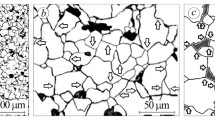The contemporary level of pipe rolling technology makes it possible to manufacture line pipes of strength class K42–K65 in corrosion- and cold-resistant versions. Pipes of this type are intended for building oil and gas pipelines that are used for developing fields, including those in the Far North. Avoidance of the main defects of both steel smelting and pipe rolling origin, revealed during pipe piercing and rolling, is an important problem for metallurgists in both domestic and overseas pipe plants. A reduction in scrap of metallurgical origin is facilitated by the use of advanced steel smelting technology in electric-arc furnaces followed by extra-furnace treatment and continuous billet casting. Steel 06GBA has been developed with the aim of improving pipe outer surface quality as a result of reducing carbon content and adding niobium. Replacement of steel grade 10GFBYu by steel 06GBA makes it possible to improve the output of finished pipes considerably.









Similar content being viewed by others
Author information
Authors and Affiliations
Corresponding author
Additional information
Translated from Metallurg, No. 11, pp. 105–109, November, 2015.
Rights and permissions
About this article
Cite this article
Utkin, I.Y., Uskov, D.P., Frantov, I.I. et al. Assimilation of New Steel Alloying Composition for Manufacturing Line Pipes of Strength Classes K52–K55. Metallurgist 59, 1111–1117 (2016). https://doi.org/10.1007/s11015-016-0223-9
Received:
Published:
Issue Date:
DOI: https://doi.org/10.1007/s11015-016-0223-9




